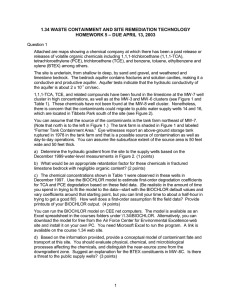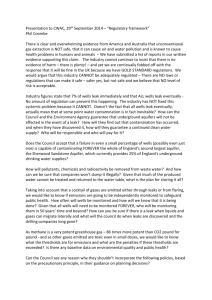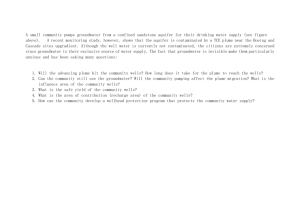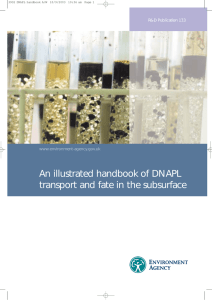1.34 WASTE CONTAINMENT AND SITE REMEDIATION TECHNOLOGY
advertisement
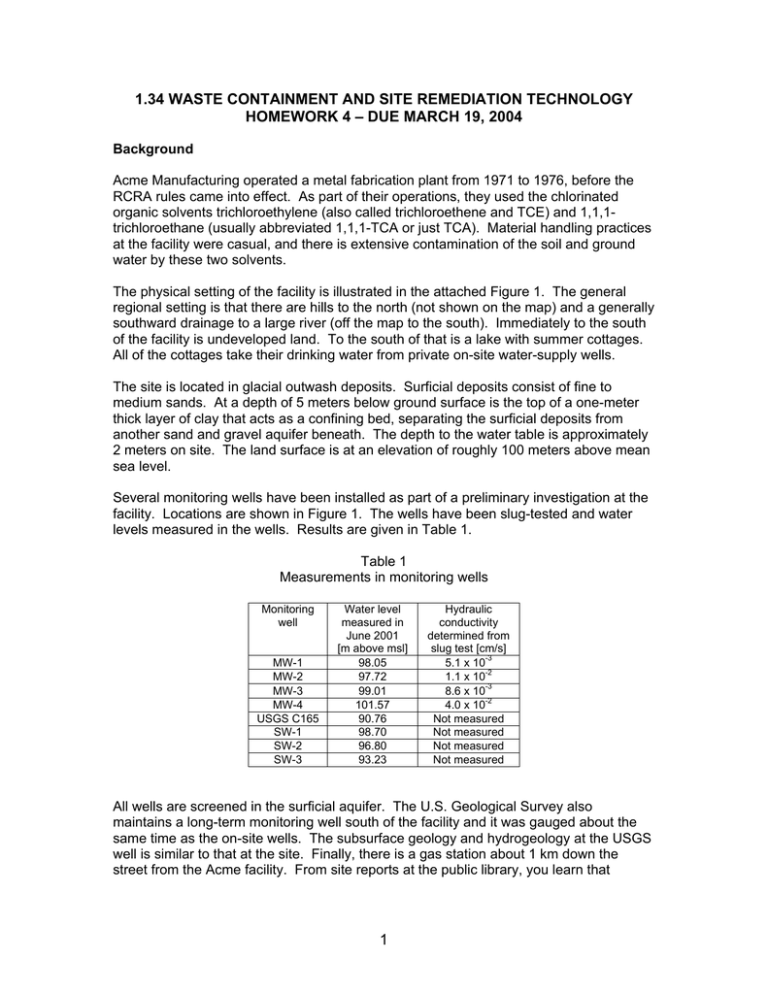
1.34 WASTE CONTAINMENT AND SITE REMEDIATION TECHNOLOGY HOMEWORK 4 – DUE MARCH 19, 2004 Background Acme Manufacturing operated a metal fabrication plant from 1971 to 1976, before the RCRA rules came into effect. As part of their operations, they used the chlorinated organic solvents trichloroethylene (also called trichloroethene and TCE) and 1,1,1trichloroethane (usually abbreviated 1,1,1-TCA or just TCA). Material handling practices at the facility were casual, and there is extensive contamination of the soil and ground water by these two solvents. The physical setting of the facility is illustrated in the attached Figure 1. The general regional setting is that there are hills to the north (not shown on the map) and a generally southward drainage to a large river (off the map to the south). Immediately to the south of the facility is undeveloped land. To the south of that is a lake with summer cottages. All of the cottages take their drinking water from private on-site water-supply wells. The site is located in glacial outwash deposits. Surficial deposits consist of fine to medium sands. At a depth of 5 meters below ground surface is the top of a one-meter thick layer of clay that acts as a confining bed, separating the surficial deposits from another sand and gravel aquifer beneath. The depth to the water table is approximately 2 meters on site. The land surface is at an elevation of roughly 100 meters above mean sea level. Several monitoring wells have been installed as part of a preliminary investigation at the facility. Locations are shown in Figure 1. The wells have been slug-tested and water levels measured in the wells. Results are given in Table 1. Table 1 Measurements in monitoring wells Monitoring well MW-1 MW-2 MW-3 MW-4 USGS C165 SW-1 SW-2 SW-3 Water level measured in June 2001 [m above msl] 98.05 97.72 99.01 101.57 90.76 98.70 96.80 93.23 Hydraulic conductivity determined from slug test [cm/s] 5.1 x 10-3 1.1 x 10-2 8.6 x 10-3 4.0 x 10-2 Not measured Not measured Not measured Not measured All wells are screened in the surficial aquifer. The U.S. Geological Survey also maintains a long-term monitoring well south of the facility and it was gauged about the same time as the on-site wells. The subsurface geology and hydrogeology at the USGS well is similar to that at the site. Finally, there is a gas station about 1 km down the street from the Acme facility. From site reports at the public library, you learn that 1 ground-water monitoring wells SW-1, SW-2 and SW-3 have been installed for this site and their water-levels measured as shown in Table 1. On-site, monitoring well MW-3 penetrated a pool of DNAPL on top of the clay layer. A sample of the DNAPL was sent to a laboratory for analysis. They found the DNAPL to consist of 40% TCE and 60% TCA by weight. Because of the presence of DNAPL, onsite borings were not extended into the clay. Soil samples were collected from the surficial aquifer. Analysis of the soil samples indicated a soil bulk density of 1.65 g/cm3 and a fraction organic carbon of 0.0012. Porosity is estimated to be 0.3. You have been tasked with completing a preliminary analysis of the site to assess the feasibility of site cleanup. The following are your specific tasks: 1. Assume that the pool of DNAPL acts as a source of ground-water contamination. Estimate the concentration of TCE and TCA in the ground water at the source. (1 point) 2. Draw a contour map of the water table based on the information above and in Figure 1. Estimate the direction and slope of the hydraulic gradient. (2 points) 3. The entire Acme facility can be considered a potential source and needs to be hydraulically contained. Assuming one well can be used to create the necessary capture, determine the total pumping rate Q needed for a downgradient pump-and-treat system to capture ground water flowing from the 200-meter-wide site. (2 points) 4. Pick an appropriate location for a pump-and-treat well on the site map. Compute and plot the bounding streamline of water flowing into the well assuming the well is located at (x,y) = (0,0). What is the distance between the well and the stagnation point? (These calculations are probably most easily done in a spreadsheet.) (2 points) 5. Is a single well practical? (2 points) You can use this rule of thumb for estimating drawdown in a well in an unconfined aquifer: s 1500 = Q T where s is drawdown in feet, Q is pumping rate in gpm, and T is transmissivity in gpd/ft. (Note: Q/s is called the specific capacity of the well.) 6. You propose to evaluate the level of ground-water contamination in the aquifer underlying the clay layer by installing more wells. What special considerations are required for this field work? (1 point) 2

